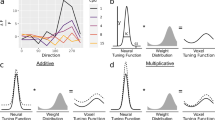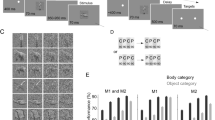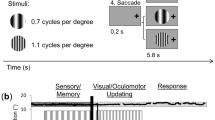Abstract
Classification methods show that the spatial pattern of a functional magnetic resonance imaging response across the cortex contains category information, but whether such patterns are used, or 'read out', in behavioral performance remains untested. We show that although the spatial pattern in both the retinotopic and lateral occipital cortex (LOC) in humans contains category information, only in the LOC is the pattern stronger for correct than for incorrect trials. Thus, some, but not all, spatial patterns are read out during task performance.
This is a preview of subscription content, access via your institution
Access options
Subscription info for Japanese customers
We have a dedicated website for our Japanese customers. Please go to natureasia.com to subscribe to this journal.
Buy this article
- Purchase on SpringerLink
- Instant access to full article PDF
Prices may be subject to local taxes which are calculated during checkout

Similar content being viewed by others
References
Haxby, J.V. et al. Science 293, 2425–2430 (2001).
Cox, D.D. & Savoy, R.L. Neuroimage 19, 261–270 (2003).
Kamitani, Y. & Tong, F. Nat. Neurosci. 8, 679–685 (2005).
Kamitani, Y. & Tong, F. Curr. Biol. 16, 1096–1102 (2006).
Langleben, D.D. et al. Hum. Brain Mapp. 26, 262–272 (2005).
Haynes, J.P. & Rees, G. Nat. Neurosci. 8, 686–691 (2005).
Kriegeskorte, N., Goebel, R. & Bandettini, P.A. Proc. Natl. Acad. Sci. USA 103, 3863–3868 (2006).
Bar, M. et al. Neuron 29, 529–535 (2001).
Grill-Spector, K., Kushnir, T., Hendler, T. & Malach, R. Nat. Neurosci. 3, 837–843 (2000).
Grill-Spector, K., Knouf, N. & Kanwisher, N. Nat. Neurosci. 7, 555–562 (2004).
Op de Beeck, H.D., Baker, C.I., DiCarlo, J.J. & Kanwisher, N.G. J. Neurosci. 26, 13025–13036 (2006).
Afraz, S.R., Kiani, R. & Esteky, H. Nature 442, 692–695 (2006).
Chambers, C.D. & Mattingley, J.B. Trends Cogn. Sci. 9, 542–550 (2005).
Cohen, M.R. & Newsome, W.T. Curr. Opin. Neurobiol. 14, 169–177 (2004).
Hampton, A.N. & O'Dohery, J.P. Proc. Natl. Acad. Sci. USA 104, 1377–1382 (2007).
Acknowledgements
We thank C. Baker, D. Dilks, H. Op De Beeck, J. Haushofer, A. Rich, R. Saxe, B. Schwarzlose, E. Vul and U. Zohary for their comments and suggestions on this work. M.A.W. was supported by a grant from the Australian National Health and Medical Research Council (C.J. Martin Fellowship). This work was supported by a grant from US National Institutes of Health to N.G.K (grant 13455).
Author information
Authors and Affiliations
Corresponding author
Ethics declarations
Competing interests
The authors declare no competing financial interests.
Supplementary information
Supplementary Fig. 1
A single exemplar from each stimulus of the three categories. (PDF 84 kb)
Supplementary Fig. 2
Behavioral performance: mean percent correct for the three stimulus categories. (PDF 46 kb)
Supplementary Fig. 3
Mean percent signal change for the two categories for correct and incorrect trials in the retinotopic cortex and lateral occipital complex. (PDF 126 kb)
Supplementary Fig. 4
Mean correlations for the same and different categories in the LOC when equal numbers of correct and incorrect trials were used in the analysis by removing a random subset of correct trials. (PDF 47 kb)
Supplementary Fig. 5
Mean correlations for same and different categories for correct and incorrect trials in the lateral occipital complex, after the number of voxels in the LOC was equated to that of the FFA by increasing the statistical threshold of the LOC localizer resulting in a contiguous ROI with equal number of voxels. (PDF 64 kb)
Rights and permissions
About this article
Cite this article
Williams, M., Dang, S. & Kanwisher, N. Only some spatial patterns of fMRI response are read out in task performance. Nat Neurosci 10, 685–686 (2007). https://doi.org/10.1038/nn1900
Received:
Accepted:
Published:
Issue Date:
DOI: https://doi.org/10.1038/nn1900



